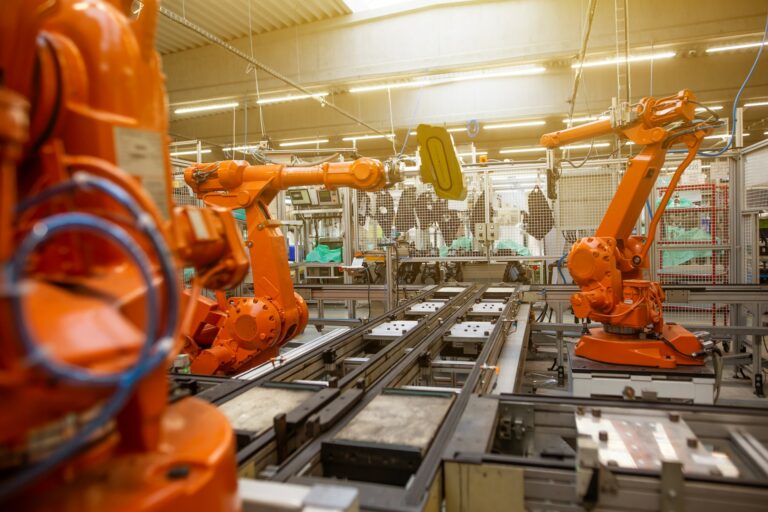July 7, 2023
Blog
AI in Manufacturing: 10 Ways AI Is Changing the Manufacturing Industry
The face of manufacturing is changing at a rapid pace. Quality standards continue to rise alongside the demand for higher output and accelerated rates of production. Implementing novel AI and machine learning (ML) systems makes meeting that standard possible.
The following are the top 10 benefits of AI in manufacturing, along with brief explanations of the impact of each:
- Predictive Maintenance
- Machine Maintenance
- Quality Control
- Automated Inspection
- Workplace Safety
- Augmenting Human Roles
- Cybersecurity
- Logistics Optimization
- Inventory Management
- Supply Chain Optimization
1. Predictive Maintenance
With advanced predictive maintenance capabilities, AI can use production data—such as data collected from sensors—to predict and prevent potential equipment failures. This data is also used in scheduling routine maintenance checks.
According to the Deloitte Analytics Institute, on average, predictive maintenance allows manufacturing facilities to:
- Improve productivity by 25%
- Reduce equipment breakdowns by 70%
- Lower maintenance costs by 25%
Predictive maintenance is quickly becoming an essential component of modern manufacturing.
2. Machine Maintenance
In addition to predictive maintenance, AI is used for other forms of machine maintenance, including:
Asset management
AI can process input data to identify the ideal moment to fix machinery and replace parts, and is able to infer whether future repair costs indicate it’s time to retire/replace equipment.
Performance assessment
AI can examine past machine performance and assess whether adjustments will increase output capacity. AI correlates seemingly unrelated data points from multiple phases of the manufacturing process to recommend modifications that significantly increase yield.
3. Quality Control
AI uses ML to identify material defects and contaminants across multiple stages of production. As time progresses, results from this data are compiled to increase the technology’s accuracy. Generative AI’s self-correcting, self-regulating informational feedback loop automatically adjusts parameters as needed as it compiles existing data with actively collected data, responding to errors in real time and preventing future ones.
4. Automated Inspection
Automated inspection is utilized in advanced facilities when absolute precision (beyond what the human eye can detect) is needed.
For example, Automated Optical Inspection (AOI) systems use AI, ML, computer vision, robotics, and microscopy to identify and assign causality to flaws and anomalies that may arise during precision production.
Inspection is one of the most vital AI applications in manufacturing, and is used in aerospace, semiconductor manufacturing, genomics, automotive, and consumer electronics sectors where defects or contaminants at the nanoparticle level can yield critical failures in final products.
5. Workplace Safety
AI assists manufacturing operations on multiple fronts with regards to workplace safety. The following are a few ways AI minimizes risks:
- Anticipating risks tied to equipment failures
- Predicting the likelihood of accidents in specific areas of a facility
- Tracking workers to ensure they are wearing protective gear
- Identifying if workers aren’t following normal procedure, signaling something may be wrong
- Providing analysis for ways to improve training and employee education
- Monitoring environmental conditions and warning at the sign of smoke, fire, or other dangers
6. Augmenting Human Roles
AI is ideal when handling large amounts of data and accurately managing redundant and repetitive tasks. But, when it comes to fully automated physical processes, AI-powered robots benefit organizations best when operating collaboratively with the human workforce.
These collaborative robots, or “cobots”, can be programmed for specific tasks, reduce injury from redundant physical labor, and dramatically increase efficiency.
7. Cybersecurity
A cyber-attack is one of the top threats currently posed to organizations. AI can help keep systems secure by:
- Monitoring logins and employee use
- Detecting unusual internal activity
- Recognizing signs of malware or fraud schemes
- Monitoring connections to cloud computing
- Using machine operations sensors to recognize potential Internet of Things (IoT) attacks.
8. Logistics Optimization
AI can assess data from shipping and deliveries, traffic routes, and product inventory. This can save organizations time and fuel costs in transit, and prevent stockouts that halt production.
9. Inventory Management
Similar to the ability to monitor inventory and plan the optimal time and amount of products to order, AI can further compute and analyze trends in sales, production schedules, and other company data.
This can be used to optimize storage costs and inventory capacity, and address ways to adjust operations in order to remain competitive compared to market trends.
10. Supply Chain Optimization
AI is able to uncover improvements to a company’s functions across the entire supply chain. Because it can process large datasets and apply rules-based routines, AI can combine logistics data with metrics shared between an organization and its suppliers and/or retailers.
With this capability, AI can assist in improving a company’s sourcing, procurement, strategy formation, risk management, and lead-times.
Use AI in Manufacturing to Maximize Efficiency
Optimize your smart manufacturing facility using Nanotronics’ full-factory nControl™ solution. We synthesize hardware and software systems to supplement human ingenuity. Our AI-backed process control platform helps you increase yield without compromising the highest quality standards.
Learn more about our products by getting in touch with us today.

